The Palm Springs Aerial Tramway:
Travels over two-and-one-half miles along the cliffs of Chino Canyon, transporting visitors to the pristine wilderness of the Mount San Jacinto State Park and Wilderness Area. During this ten-minute journey, tram cars rotate slowly, offering spectacular vistas of the valley below.The Tram’s Mountain Station:
Elevation 8,516 feet and 30 degrees cooler than the desert floor. Dine in two restaurants, enjoy viewpoints, hike over 50 miles of trails, watch two documentary films or visit the natural history museum. Overnight camping available with advance reservation.In the winter (snow conditions permitting), enjoy snowshoeing or cross-county skiing in an Alpine wonderland.
https://visitpalmsprings.com/things-to-do/palm-springs-aerial-tramway
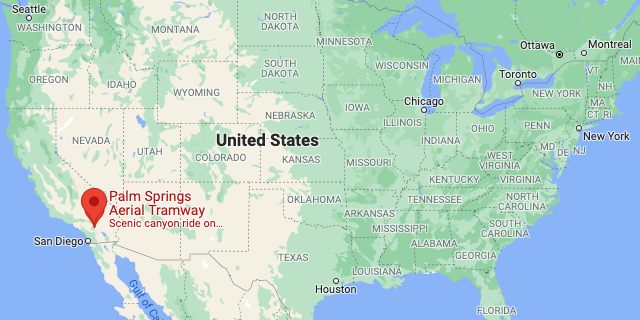
https://www.google.com/maps/place/Palm+Springs+Aerial+Tramway
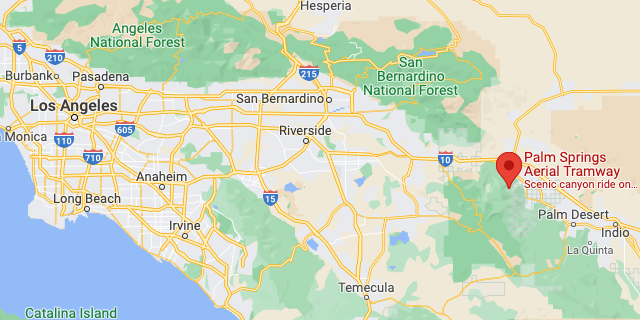
https://www.google.com/maps/dir/Los+Angeles/Palm+Springs+Aerial+Tramway

https://www.google.com/maps/search/Palm+Springs+Aerial+Tramway
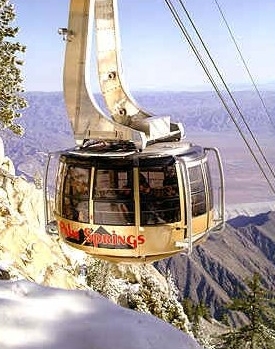 Fact Sheet:
Fact Sheet:- Opened: September 1963
- Capacity: Two 80-passenger enclosed rotating cars
- TRAM Distanced Traveled: Approximately 12,800′ with vertical ascent of 5,873′ – 15 minutes travel time one way.
- TRAM Basic Technical Facts: Five towers support four 1-7/8″ steel cables as well as four hauling cables, two auxiliary cables and a communications cable. The first tower is the tallest at 214′ high; Tower Number Four is the shortest at 56 1/2′ high. The weight of steel in the five towers totals 263 tons; the weight of the 11 cables totals 330 tons. The maximum span between towers is 3,455′ between Towers 3 and 4.
- Departures: Cars depart at least every half hour from 10 a.m., Monday-Friday; 8 a.m. weekends and holiday periods. Last car up is 8 p.m. with the last car down at 9:45 p.m.
- Elevation of lower terminal (Valley Station): 2,643 feet
- Elevation of upper terminal (Mountain Station): 8,516 feet
- Difference of elevation: 5,873 feet
- Actual length traveled along cables: 12,780 feet
- Average gradient: 26 degrees
- Maximum gradient: 42 degrees
- Number of intermediate towers: 5. The first tower is the tallest at approximately 227 feet
- Car dimensions: 8ft high inside 18ft in diameter
- Weight (carriage, hanger and cabin) empty: 22,000 lbs
- Weight (carriage, hanger and cabin) loaded: 13,600 lbs
- Total weight: 35,600lb 16,200kg
- Capacity of each car: Approx. 80 passengers plus 1 car operator
- Maximum existing traveling speed: 1,970 linear feet per minute 21 mph
- FACT: Each pair of track cables is tensioned by counterweights at the Valley Station, weighing in excess of 120 tons each.
- FACT: The haul and counter ropes are tensioned by a counterweight at the Mountain Station weighing 67 tons.
https://www.palmsprings.com/attractions/palm-springs-aerial-tram

1932:
Credit for conceiving the tramway project goes to Francis Crocker, manager of the California Electric Power Company, who came to Palm Springs in 1932.
At that time, there were only a couple hundred people living in Palm Springs.
It had one cafe, one grocery, one drug store and a small branch bank.
There was no air conditioning in those days, and Crocker thought it would be wonderful to travel quickly up to the mountain where it was cool.
He said so, and kept saying so, even though, at first, most folks though the notion preposterous. But he eventually enlisted local supporters, including Earl Coffman, owner of the Desert Inn, Palm Springs' first and most famous resort hotel.
1945:
Crocker spent the next 30 years planning, financing, and building the tramway.
Conservationists were initially opposed the idea, and it wasn't until 1945 that Governor Earl Warren signed a bill authorizing the project.
But it was another 16 years - when Governor Pat Brown became a supporter of the project in 1961, that bonds were issued so financing and construction could begin.
1962:
These delays of almost three decades, actually had a beneficial effect on the project.
Technology had greatly improved since the time the original plans had been drawn.
When construction on the first tower finally began in August, 1962, both the route and the number of towers required were changed.
Technical advances had made it possible to spin heavier track cable capable of supporting two 80-passenger cars.
Other technological advances allowed the number of towers to change from 9 to 5, and meant that instead of requiring a midway transfer station, the mile ascent could be made in one sweep.
This would make the tramway the longest single span lift in the world at 2.5 miles
It also meant that in spite of increased construction costs, the 1961 costs were $3 million less than estimate from the 1940s.
Construction:
Because of the wilderness designation of Long Valley at the top surrounding Mountain Station, no road construction was allowed.
The only overland route, weather permitting, would be from Idyllwild, a small mountain community on the far side of Mt. San Jacinto.
Access to the initial construction site at Valley Station was no problem.
A 4-mile road was built from Route 111 to the location.
But the movement of men and materials to the other 4 towers sites and Mountain Station itself presented a real challenge, especially since workers were given only 660 days to complete the project.
Materials dropped off by Helicopter:
Another technological advance, the helicopter, saved the day.
The tramway became one of the largest construction projects ever undertaken involving transportation of materials by helicopter.
Helipads were built near each of the tower sites and made more than 23,000 flights, hauling more than 5,500 tons with average loads of 700 pounds.
It was often necessary to disassemble heavy equipment which would be flown to the workplace location and reassembled.
Before it was over, approximately 600 tons of steel were used in the fabrication of the tramway cables and towers using more than 27 miles of locked-coil cable, wire rope and strand. The main four rolls of track cable came in 60 ton spools, 13,500 feet long, 1 7/8 inches in diameter. To complete installation of these cable, a giant hoist with a 100-ton capacity was flown in pieces to Mountain Station.
October 12, 1963
The Palm Springs Aerial Tramway was officially opened with a ribbon cutting ceremony by Governor Pat Brown and a group of 50 businessmen and celebrities who paid $1,000 each to make the maiden ascent to the top.
2000:
The Tramway announced that it was embarking on an ambitious modernization program that would see the construction and installation of new cars and an update of its facilities.
Beginning in September 2000, passengers first rode the world’s largest rotating tramcars.
The tramcars do not rotate, the floor inside of the tramcars slowly rotate giving the rider a 360 degree views of the canyon that leads to the station at the top
How it works:
The light tramway cars hold 80 people each and are suspended from a carriage that holds 24 grooved wheels which ride upon the track cables.
The cars are pulled by two pairs of traveling, hauling cables, moving in idler pulleys over the tower saddles.

double reversible:The tramway is known as a double reversible type of aerial tramway. Each car remains on one pair of track cables moving up and down without turning around. Each car serves as a counter balance to the other, the descending car is helping pull the ascending car up the mountain
Power is provided by a 1,000-horsepower electric motor. The traveling hauling cables are pulled over a 9-foot diameter bull wheel located at Valley Station. Power is needed only to move the under balanced part of the load, provide acceleration and to overcome friction.
Maximum load on the power system occurs when there is an empty car coming down and a full one going up. When a more heavily loaded car is coming down, the system acts in reverse, serving as a brake.
https://www.desertusa.com/desert-california/palm-springs-aerial-tramway.html

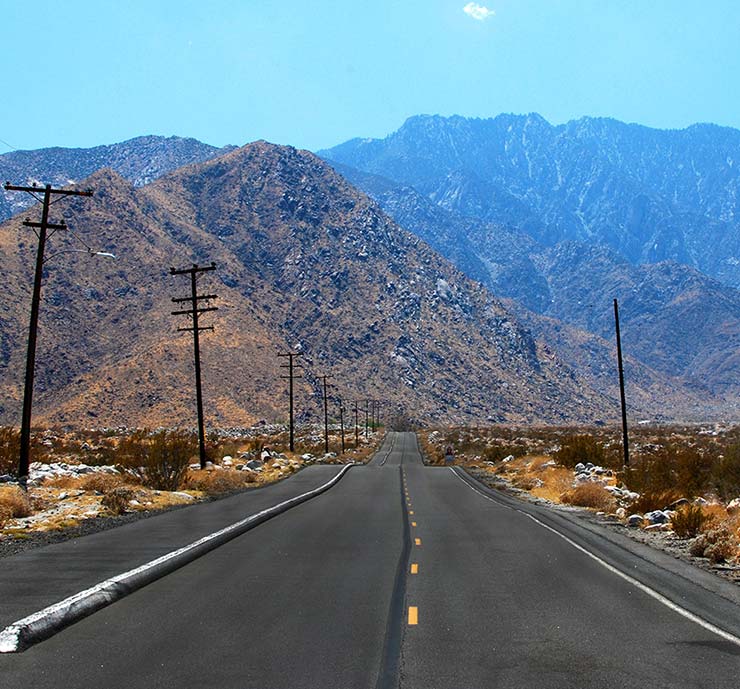
The road up to the Valley Station. When you finally reach this main entrance to the tramway, you will first encounter parking. Parking is $10 per vehicle, and you pay at this entry station. From there, they will direct you to a parking lot.

Shuttle Bus:
Buy tickets in advance on the Palm Springs Aerial Tramway website. At each parking lot, a shuttle will pick you up and take you the rest of the way to the Valley Station where you wait for the next tram going up the mountain. The trams come on average every 30 minutes, so the wait is never too long.
https://www.ohmeohmyblog.com/palm-springs-tramway-everything-you-want-to-know
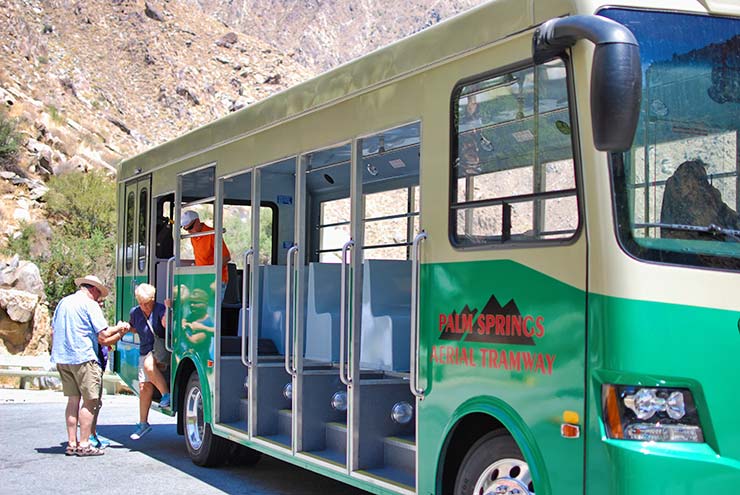

The ride up to the top was smooth and offered amazing views. During the trip, you pass through five unique life zones, from the Mexican Sonoran Desert to an Alpine wilderness. The Mount San Jacinto State Park and Wilderness Area encompasses 14,000 acres of pristine wilderness and offers a wide range of recreational activities from self-guided nature walks (3/4-mile loop) to expert level hiking trails (12-mile round trip hike). Camping is allowed in the primitive campsites designated throughout the State Park (permits are required, reservations are recommended).

The Weather:
During the summer months, the high temperatures at the Mountain Station are cool – in the 70s – while much of the Palm Springs desert area is usually over 30 degrees warmer. Winter months can range from in the 50s to below freezing. Snow is common in winter and spring, with several inches or feet of snow on the ground.
http://www.ladybugblog.com/day-trip-to-palm-springs-aerial-tramway




The tram station is about 15 minutes west of downtown Palm Springs off the main road. There is a $10 fee to park your car at the tram station. There are several parking areas, and when you go through the pay station, they’ll direct you to the appropriate lot that is open. Ideally you’ll park in Lot A, which is closest to the tram station. If it’s crowded, you’ll be in a lower lot where you need to take a shuttle bus.

The Tram Station:
Go upstairs at the tram station for departures. There’s a large waiting room where you can buy tickets, use bathrooms, and visit a small gift shop. You can also buy tickets online before you arrive.

The Ride:
Half of the fun is taking the tram from the bottom up to Mountain Station, which sits at 8,516 feet.
The tram is the world’s largest rotating aerial tramway, starting in the Sonoran desert and ending in an alpine zone.
During the ride, the floor slowly turns, allowing everyone to share the best views.
And the tram crosses over five towers, with the car experiencing a small swing after going over them.
Wind can also make the cars sway.

The Swiss-built tram is regularly maintained and inspected, and has a great safety track record, but it can be intense for those with a fear of heights.
Once at the top, in Mountain Station, you are at a tourist attraction. There are restaurants, viewpoints, gift shops, bathrooms, and interpretive displays. It’s a fun place, built in the mid-century modern style that Palm Springs is famous for. I recommend budgeting some time in after your hike to grab a bite and enjoy it.

https://hikingguy.com/hiking-trails/best-la-hikes/palm-springs-tram-hike-to-san-jacinto-peak
Hiking:
Once you get to Mountain Station, take the stairs down and go outside. Go down the paved path by the San Jacinto State Park sign. There will be a trail board and trail signs and the Long Valley Ranger Station where you can fill out a permit so they can track who is out on the mountain.
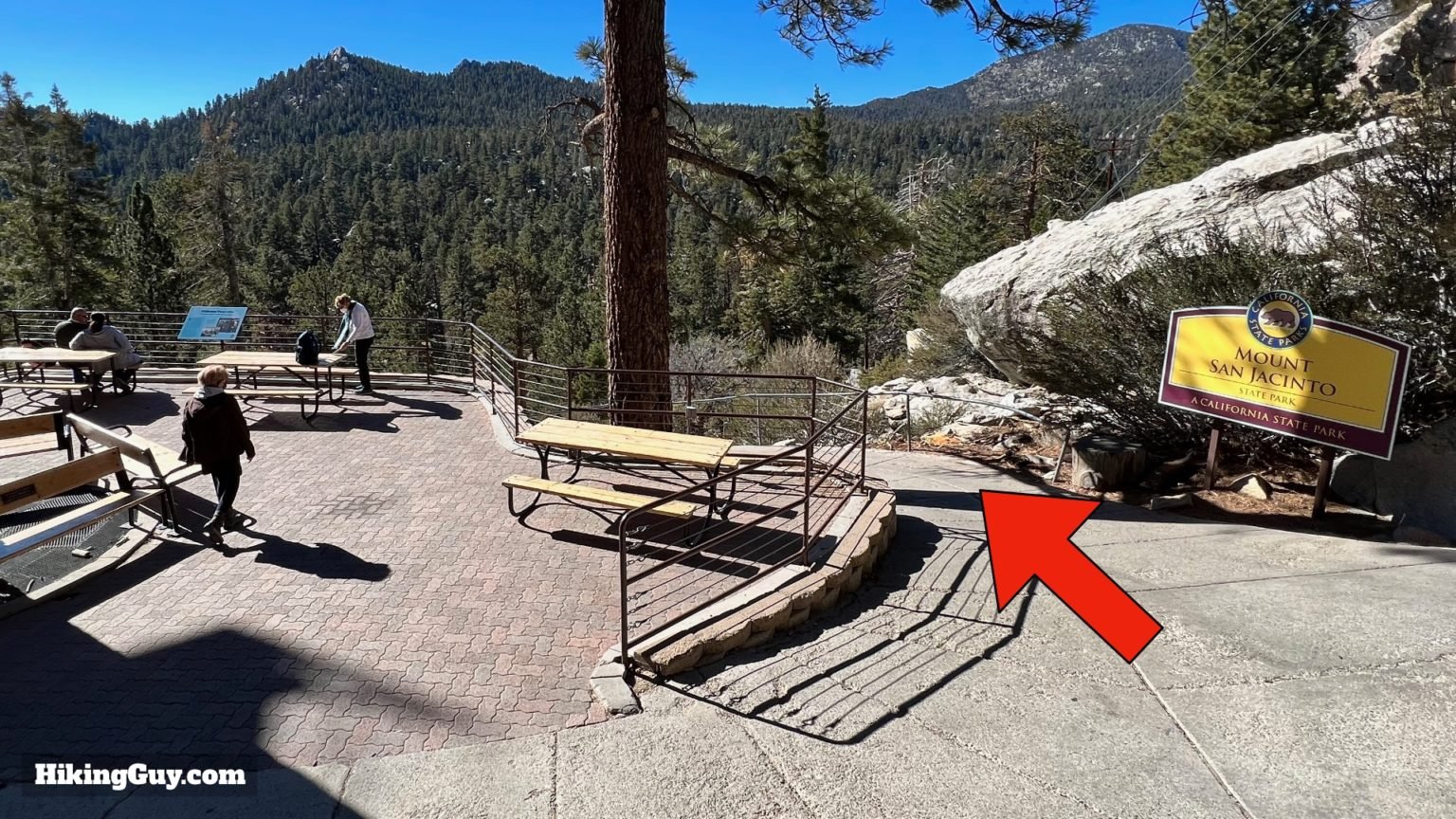


If your kids hate heights, the tram ride to the top might be a problem. My kids loved it though the tram car sways over each of the five towers. I found the ride to be gentle and quiet; it takes about 10 minutes to climb 6,000 feet. During our ride, the kids in our tram were great. A few of the older adults experienced slight vertigo issues with the tram car’s rotation. I suggest riding in the center of the tram and giving kids gum to chew to help with their popping ears.

Hiking:
The Mount San Jacinto State Park offers 54 miles of trails. During our visit, we hiked from the Mountain Station to the Ranger Station and then to Grubb’s View. The Mount San Jacinto State Park offers guided walks during the summer season from Memorial Day to Labor Day, every weekend. Volunteers guide hikers along a 40-minute walk and point out various plants and animals. Free.
Winter Wonderland:
The flurries start to fall around Thanksgiving and the snow lingers through the winter. This is the only area near Palm Springs with a snow play area for sledding, snow shoeing, or cross-country skiing. The Adventure Center located near the Mountain Station offers snowshoe rentals and cross-country ski equipment. Sleds can be purchased along with winter-related items.
https://www.travelingmom.com/palm-springs-aerial-tramway-worlds-largest-rotating-tram-cars
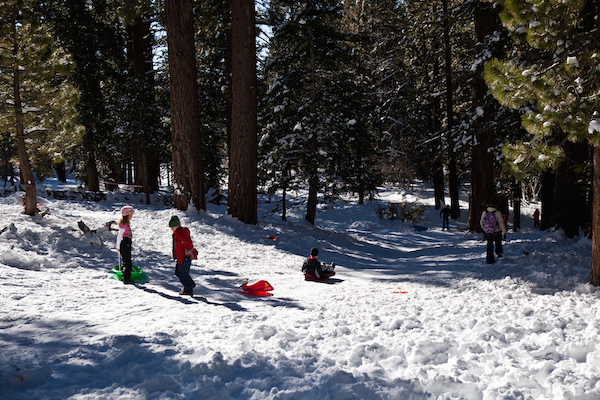

Snowshoeing in Mount San Jacinto State Park atop the Palm Springs Aerial Tramway is one of those quintessential SoCal experiences. One minute you’re basking in desert sunshine; 10 minutes later, you’re at 8,500 feet strapping on platforms that will enable you to walk through a snowy wonderland. Breathe in the fresh mountain air and feel the chill on your face as you hike through snow-covered forests of pinyon, big cone, and Jeffrey pine. But the real fun of snowshoeing is heading off trail to explore the deeper snow. Feel light as a feather as you trek across the snow’s surface, moving with speed and agility, while those without snowshoes sink in over their knees.

The Adventure Center:
At the Adventure Center you can rent snowshoes, cross-country skis, and snow boots; they even sell hats and gloves, in case you’re particularly unprepared. The friendly staff will help you set up your gear and give you brief tips and pointers to get you going. If you’ve never snowshoed, fear not—you basically just walk! Once you reach the top of the tram, head to the Adventure Center, which is open whenever the snow is deep enough.


Long Valley is at an elevation of 8,400 feet at the top of the Palm Springs Aerial Tramway. Prior to the tramway being built in 1963, Long Valley was considered the "backcountry" of Mount San Jacinto State Park where Park Rangers and Aides would patrol on horseback from the park headquarters in Idyllwild eastward. However, Long Valley is now the most visited part of the park due to the access provided by the tramway.
A variety of trails begin from Long Valley, the most popular of which are described below according to difficulty. If you are planning a hike into the State Wilderness, you must stop at the Long Valley Ranger Station to fill out a free day-use permit. Campers must also check into the Long Valley Ranger Station prior to heading to their primitive wilderness campsite.
Easy Hike:
- Discovery Nature Trail
- 0.6 mile roundtrip (loop)
- Flat and level, good footing, suitable for children
- Minimal elevation gain
- Does not require wilderness permit
Moderate Hike:
- Desert View Trail
- 1.5 miles roundtrip (loop)
- 50 feet elevation gain
- Some rocky sections, suitable for older children
- Does not require wilderness permit
Strenuous Hikes:
- Round Valley Loop Trail
- 4.0 miles roundtrip (loop)
- 600 feet elevation gain
- Requires wilderness permit
- To Round Valley Meadow
- 4.2 miles roundtrip (out-and-back)
- 700 feet elevation gain
- Requires wilderness permit
Very Strenuous Hikes:
- To Wellman Divide
- 1,300 feet elevation gain
- 6.2 miles roundtrip (out-and-back)
- Requires wilderness permit
- To San Jacinto Peak
- 11.6 miles roundtrip (out-and-back)
- 2,400 feet elevation gain
- Requires wilderness permit

Although the popular Palm Springs attraction has a restaurant, a bar, and a food counter – you don’t have to get your food and drinks there, because you are allowed to bring your own. So, if you want to have a picnic after a long hike or maybe some wine or beers with someone you love while taking in the incredible views (not a bad date night), just pack them into a cooler or backpack and bring them up the tram.
They Have Lockers:
Do note, that if you plan on hiking around and don’t want to be stuck carrying a cooler, picnic basket, thermos, or whatever – bring up some quarters and get a locker. There are a few dozen lockers available on the bottom level of the tram station – with decent size ones going for $1.25 and larger for $1.50. Not a bad price to pay for not having to walk around carrying sandwiches all day. There is a quarters machine as well, if you have dollar bills on you.
https://www.cactushugs.com/yes-you-can-bring-your-own-food-up-the-palm-springs-tramway


A sign notes that from where I’m standing the San Andreas Fault parallels Interstate 10, the fault system’s forces having etched the current landscape with its pulling, straining, lifting, and dipping over millions of years.
https://theroadstraveled.com/palm-springs-aerial-tramway
The tramcar, its interior dimensions 18 feet in diameter and eight feet high, accommodates up to 80 passengers and a weight of 35,600 pounds. It travels 12,708 feet of cables, and passes through five towers, the first being the tallest at 227 feet. The floor of the tramcar slowly rotates twice during the trip, affording us full 360 degree views. The ride is smooth, with slight vibrations as we move through the cable towers, and otherwise quiet, except for our excited chatter as we ooh and aah our way upward.


During Construction they needed over 23,000 separate helicopter missions to transport crew and materials in order to construct its 4 tramway support towers and the massive 35,000 square foot Mountain Station above. This remarkable effort finally earned it the designation as a historical civil engineering landmark in the 1980s.
No Bad Seat:
The ride up and down is a majestic sight to behold with the Coachella Valley sprawling below and the shear cliffs and peaks of Mount San Jacinto looming above. It’s also a little daunting with its big sways to & fro as it passes by each support tower, but that just adds to the fun.
There’s no bad seat in the tramcar thanks to the rotating view which alone makes it worth the price of admission.
That’s when you remember you have an entire state park to explore once you’ve reached the top!
30 Degrees Cooler:
The first thing you’ll notice when you step off the tramcar is the crispness in the air thanks to the mountain’s perched position some 8,500 feet above the desert floor.
The 30 degree temperature drop makes it the perfect respite during the warm months of a Palm Springs summer and it’s typical to be covered in a thick layer of snow all the way into May.
Hiking Trails:
There’s hiking trails galore all throughout the forested wilderness of Mount San Jacinto (over 50 miles worth). If you’re short on time, Desert View Trail is the perfect choice. This 1.5 mile loop takes you to various lookout points right along the mountain’s edge (so watch your step), offering one magnificent vista after another.

Original Tramcars:
The tramcars with red or blue trim were used until an ambitious modernization program was completed in 2000 that saw an update to all facilities including 2 brand new rotating tramcars. To this day, they’re still the largest rotating tramcars in the world!
https://www.californiabychoice.com/home/palm-springs-aerial-tramway





Hours: 11AM - 4PM
| 4.2 | (1,002) | $$ |
https://goo.gl/maps/FxqYEutMSXZHUCrt8
Appetizers and Salads Menu:

The Palm Springs Aerial Tramway in Palm Springs, California, is the largest rotating aerial tramway in the world. It was opened in September 1963 as a way of getting from the floor of the Coachella Valley to near the top of San Jacinto Peak and was constructed in rugged Chino Canyon. Before its construction, the only way to the top of the mountain was to hike hours from Idyllwild. The rotating cars were added in 2000.Palm Springs Aerial Tramway:
- The twelve-and-a-half minute ride begins at the Valley Station at 2,643 feet and passes up a sheer mountain face through five life zones (biomes) on its way to the Mountain Station at 8,516 feet above sea level.
- Travelers start in the Sonoran Desert and arrive at an alpine forest.
- The air can be as much as 40 °F (22 °C) cooler at the top than in the desert.
- The floor of the 18-foot-diameter (5.5 m) aerial tram cars rotates constantly, making two complete revolutions throughout the duration of the journey so that the passengers can see in all directions without moving.
- With a maximum capacity of 80 passengers, it is the largest of the three rotating aerial trams in the world. The other "Rotair" aerial trams are located in Cape Town, South Africa, and Titlis, Switzerland.

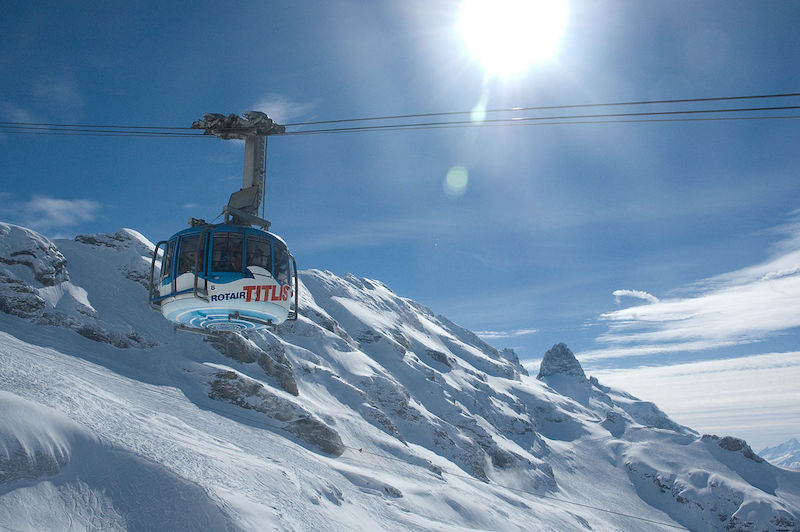
Table Mountain Cape Town: https://en.wikipedia.org/wiki/File:TableMountainAerialCableway2018.jpg
Titlis Swizerland: https://en.wikipedia.org/wiki/File:Titlis_Rotair.jpg
- The view at the top can stretch northward for more than 200 miles on a clear day, all the way to Mount Charleston north of Las Vegas, Nevada. Views to the east and west can stretch as far as 75 miles. California's Salton Sea is plainly visible to the southeast.
- There are two restaurants at the summit, one of which specializes in fine dining.
- As it was in 1963, the only way up the mountain to deliver supplies and water is via the aerial tram cars themselves. Supplies are loaded into the passenger area before the attraction's opening while fresh water is pumped into storage tanks in the car's underbelly.
HoursTram cars depart at least every 30 minutes:
- First tram up: 10:00AM. 8:00AM weekends
- Last tram up: 4:20PM
- Last tram down: 4:40PM
They have different hours for summer, weekdays and weekends. Always check with them:










